THE DANCERS filed onto the stage smoothly. The boys were dressed in warm-up pants and basketball shoes and the girls were dressed in coordinated pastel tank tops and black dance pants. Although they bounced to American hip-hop music and wore Western attire, there was no mistaking that this ensemble was performing at the Asian Pacific American Heritage Month Opening Ceremony. That's because, unfortunately, almost all the people in the audience were Asian. Does this imply the cultural cliquishness that appears on the surface or a deeper underlying problem? It seems to be the latter.
It's unfair that while activities like APAHM are meant to foster interaction between the University's diverse student body, they're criticized as promoting more self-segregation because the only people in attendance are of the ethnicity being celebrated. This criticism is a thoughtless and ignorant shrugging off of the real purpose of these cultural events, and misses the whole point of what programs like APAHM are trying to do.
February was Black Heritage Month, last week was Hispanic Awareness Week and May is Asian Pacific American Heritage Month. Since we won't be in school throughout May, the University's Asian organizations held their opening ceremony last Friday afternoon and will celebrate APAHM in April. Activities like APAHM are designed to peak students of all races' involvement in the various ethnic communities on Grounds. Just because these are ethnic groups does not make them elitist or self-seperationist by default. Instead they are working together to promote integration, and students from all backgrounds need to realize this to share in the understanding that these groups foster.
The argument against programs like APAHM is that instead of reminding students that they're assembled under a common umbrella of school pride and unity, they remind us once again of why we are all different. Some say that the proof of this divisiveness is that non-minority students don't even attend these events since they feel they aren't geared towards them.
The dismissal that cultural events are biased is incorrect. Festivals along the lines of APAHM are about sharing the particular minority culture with the rest of the students. The reason that mainly Asian students participated in APAHM is because non-Asian students don't realize that the program is really for them too and not just for the Asian community. Students need to realize that groups like the APAHM are trying to foster unity. Otherwise, the programs ironically will appear to endorse self-segregation and hurt the cause they try to help.
"It can be really frustrating sometimes to put in all this effort and not see a diverse turn-out," said Asian Student Union president Stephanie Hsu in an interview. "We sent letters to the faculty, we advertised in the newspaper and around campus, and yet we still mainly got Asian students to come out. It really creates a catch-22 situation for the minority cause."
It certainly does, because each cultural group is forced to become the performer and audience for its ethnic event, stifling that group's quest to inform everyone about its culture.
Racial issues at this University are not just black and white anymore. Although it's easier to generalize that there are only two broad groups, in addition there is also another 15-percent minority population at the University. Last week's cruel defamation of the Latino painting of Beta Bridge was a devastating reminder that students do not understand why minorities try to share their culture with everyone. It's not because they want to further the divisions of black, Asian or Hispanic. And it's not because they want to prove their culture's superiority over any other. Instead it's because each student is proud of his background, and college is a wonderful opportunity to share that with others. While inflammatory carousal like what happened on the Bridge is saddening, it's also a call to arms for students to fight harder to promote their cultures.
This month, the Asian groups on Grounds will offer guest speakers, such as Presidential Initiative On Race task force member Angela Oh, Asian-American bands and a promotion of the Asian-Pacific American Studies Program. Like the African Drum Festival that took place during Black History Month, these events are designed for members of all races to share in a different culture.
Community is created when students try to absorb a part of each culture as their own -- not just observe it as an alien object attached to someone else's identity. As Ms. Hsu said in her opening speech, APAHM is "an opportunity to bridge racial gaps via understanding." To do this, each student must recognize that she can singly promote this understanding by attending different cultural events, and not just leave it to each culture to bask in its own ethnicity.
(Diya Gullapalli is a Cavalier Daily associate editor.)




